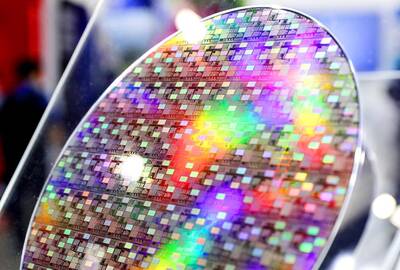Bridging a widening digital divide is a tough challenge for India, where gains from the booming economy that is growing 8 percent annually have mostly accrued to the urban middle class.
Intel Corp chairman Craig Barrett sees a part of the remedy lying in WiMAX technology, a wireless capability that provides Internet connectivity without requiring a computer to be tethered to a cable.
"India has the opportunity to be a leading commercial implementer in WiMAX capabilities," Barrett said as he toured the remote town of Baramati in western India on Thursday to explore how the US chipmaker could help in advancing efforts to empower unemployed youth and farmers with the help of information technology.
Intel has been trying to drive the adoption of WiMAX. Like its wireless cousin Wi-Fi, WiMAX delivers high-speed connections but the coverage range can stretch for kilometers.
"The conditions are absolutely ripe here in terms of the lack of rural infrastructure and what WiMAX could do," Barrett told a news conference in Baramati, a town known for innovative adoption of new technologies.
His comments, broadcast over the Internet, came after a tour of the town that took him to a local hospital using WiMAX to access the Internet for diagnostic work and a school that is implementing new technology-driven learning tools.
Baramati has been adopted by Intel under its World Ahead Program that seeks to expedite access to technology and education for people in the world's poorer nations.
He also visited farmers in outlying villages to see how information technology could be used to improve their living standards.
More than two-thirds of India's 1 billion plus people live in villages, depending mostly on agriculture. Much of rural India lacks adequate infrastructure such as good roads, electricity supplies and telephone facilities to help people improve productivity and living standards.
Farmers often lack vital information such as weather, new seeds and crop prices. Access to the Internet could help.
"The beauty of [WiMAX] is it is relatively inexpensive and relatively simple," Barrett said. "It is ideal for rural environment where there is limited infrastructure in place."
Intel is spending about US$1 billion in promoting WiMAX, he said. Trials are underway in about 200 places across the world and some 40 to 50 companies are engaged in commercial implementation, he said.
Yesterday, Barrett traveled to New Delhi, India's capital, to meet with government and business leaders.
Intel plans to invest US$1.1 billion over a five-year period ending in 2010 to expand its operations in India.
Intel said it has been successful in working with local companies to bring cheaper computers to the country's rural poor, and the company will donate 10,000 personal computers to provincial governments and teacher-training centers in the next two years.

WAITING GAME: The US has so far only offered a ‘best rate tariff,’ which officials assume is about 15 percent, the same as Japan, a person familiar with the matter said Taiwan and the US have completed “technical consultations” regarding tariffs and a finalized rate is expected to be released soon, Executive Yuan spokeswoman Michelle Lee (李慧芝) told a news conference yesterday, as a 90-day pause on US President Donald Trump’s “reciprocal” tariffs is set to expire today. The two countries have reached a “certain degree of consensus” on issues such as tariffs, nontariff trade barriers, trade facilitation, supply chain resilience and economic security, Lee said. They also discussed opportunities for cooperation, investment and procurement, she said. A joint statement is still being negotiated and would be released once the US government has made

NEW GEAR: On top of the new Tien Kung IV air defense missiles, the military is expected to place orders for a new combat vehicle next year for delivery in 2028 Mass production of Tien Kung IV (Sky Bow IV) missiles is expected to start next year, with plans to order 122 pods, the Ministry of National Defense’s (MND) latest list of regulated military material showed. The document said that the armed forces would obtain 46 pods of the air defense missiles next year and 76 pods the year after that. The Tien Kung IV is designed to intercept cruise missiles and ballistic missiles to an altitude of 70km, compared with the 60km maximum altitude achieved by the Missile Segment Enhancement variant of PAC-3 systems. A defense source said yesterday that the number of

‘CRUDE’: The potential countermeasure is in response to South Africa renaming Taiwan’s representative offices and the insistence that it move out of Pretoria Taiwan is considering banning exports of semiconductors to South Africa after the latter unilaterally downgraded and changed the names of Taiwan’s two representative offices, the Ministry of Foreign Affairs (MOFA) said yesterday. On Monday last week, the South African Department of International Relations and Cooperation unilaterally released a statement saying that, as of April 1, the Taipei Liaison Offices in Pretoria and Cape Town had been renamed the “Taipei Commercial Office in Johannesburg” and the “Taipei Commercial Office in Cape Town.” Citing UN General Assembly Resolution 2758, it said that South Africa “recognizes the People’s Republic of China (PRC) as the sole

Taiwanese exports to the US are to be subject to a 20 percent tariff starting on Thursday next week, according to an executive order signed by US President Donald Trump yesterday. The 20 percent levy was the same as the tariffs imposed on Vietnam, Sri Lanka and Bangladesh by Trump. It was higher than the tariffs imposed on Japan, South Korea and the EU (15 percent), as well as those on the Philippines (19 percent). A Taiwan official with knowledge of the matter said it is a "phased" tariff rate, and negotiations would continue. "Once negotiations conclude, Taiwan will obtain a better